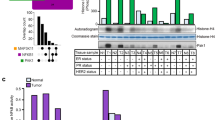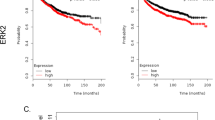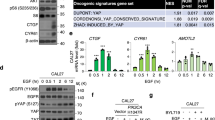Abstract
Analysis of patient tumors suggests that multiple MAP3 kinases (MAP3Ks) are critical for growth and metastasis of cancer cells. MAP3Ks selectively control the activation of extracellular signal-regulated kinase 1/2 (ERK1/2), Jun N-terminal kinase (JNK), p38 and ERK5 in response to receptor tyrosine kinases and GTPases. We used MDA-MB-231 cells because of their ability to metastasize from the breast fat pad to distant lymph nodes for an orthotopic xenograft model to screen the function of seven MAP3Ks in controlling tumor growth and metastasis. Stable short hairpin RNA (shRNA) knockdown was used to inhibit the expression of each of the seven MAP3Ks, which were selected for their differential regulation of the MAPK network. The screen identified two MAP3Ks, MEKK2 and MLK3, whose shRNA knockdown caused significant inhibition of both tumor growth and metastasis. Neither MEKK2 nor MLK3 have been previously shown to regulate tumor growth and metastasis in vivo. These results demonstrated that MAP3Ks, which differentially activate JNK, p38 and ERK5, are necessary for xenograft tumor growth and metastasis of MDA-MB-231 tumors. The requirement for MAP3Ks signaling through multiple MAPK pathways explains why several members of the MAPK network are activated in cancer. MEKK2 was required for epidermal growth factor receptor and Her2/Neu activation of ERK5, with ERK5 being required for metastasis. Loss of MLK3 expression increased mitotic infidelity and apoptosis in vitro. Knockdown of MEKK2 and MLK3 resulted in increased apoptosis in orthotopic xenografts relative to control tumors in mice, inhibiting both tumor growth and metastasis; MEKK2 and MLK3 represent untargeted kinases in tumor biology for potential therapeutic development.
This is a preview of subscription content, access via your institution
Access options
Subscribe to this journal
Receive 50 print issues and online access
$259.00 per year
only $5.18 per issue
Buy this article
- Purchase on Springer Link
- Instant access to full article PDF
Prices may be subject to local taxes which are calculated during checkout






Similar content being viewed by others
References
Al-Nedawi K, Meehan B, Micallef J, Lhotak V, May L, Guha A et al. (2008). Intercellular transfer of the oncogenic receptor EGFRvIII by microvesicles derived from tumour cells. Nat Cell Biol 10: 619–624.
Brancho D, Ventura JJ, Jaeschke A, Doran B, Flavell RA, Davis RJ . (2005). Role of MLK3 in the regulation of mitogen-activated protein kinase signaling cascades. Mol Cell Biol 25: 3670–3681.
Cazares LH, Troyer D, Mendrinos S, Lance RA, Nyalwidhe JO, Beydoun HA et al. (2009). Imaging mass spectrometry of a specific fragment of mitogen-activated protein kinase/extracellular signal-regulated kinase kinase kinase 2 discriminates cancer from uninvolved prostate tissue. Clin Cancer Res 15: 5541–5551.
Cha H, Dangi S, Machamer CE, Shapiro P . (2006). Inhibition of mixed-lineage kinase (MLK) activity during G2-phase disrupts microtubule formation and mitotic progression in HeLa cells. Cell Signal 18: 93–104.
Chandana SR, Leece CM, Gallo KA, Madhukar BV, Conley BA . (2010). Inhibition of MLK3 decreases proliferation and increases antiproliferative activity of epidermal growth factor receptor (EGFR) inhibitor in pancreatic cancer cell lines. Cancer Growth Metast 2010: 1.
Chen J, Miller EM, Gallo KA . (2010). MLK3 is critical for breast cancer cell migration and promotes a malignant phenotype in mammary epithelial cells. Oncogene 29: 4399–4411.
Cuevas BD, Abell AN, Johnson GL . (2007). Role of mitogen-activated protein kinase kinase kinases in signal integration. Oncogene 26: 3159–3171.
Cuevas BD, Winter-Vann AM, Johnson NL, Johnson GL . (2006). MEKK1 controls matrix degradation and tumor cell dissemination during metastasis of polyoma middle-T driven mammary cancer. Oncogene 25: 4998–5010.
Davidson B, Konstantinovsky S, Kleinberg L, Nguyen MT, Bassarova A, Kvalheim G et al. (2006). The mitogen-activated protein kinases (MAPK) p38 and JNK are markers of tumor progression in breast carcinoma. Gynecol Oncol 102: 453–461.
Davies H, Bignell GR, Cox C, Stephens P, Edkins S, Clegg S et al. (2002). Mutations of the BRAF gene in human cancer. Nature 417: 949–954.
Ding L, Ellis MJ, Li S, Larson DE, Chen K, Wallis JW et al. (2010). Genome remodelling in a basal-like breast cancer metastasis and xenograft. Nature 464: 999–1005.
Fedorov O, Muller S, Knapp S . (2010). The (un)targeted cancer kinome. Nat Chem Biol 6: 166–169.
Fodde R, Kuipers J, Rosenberg C, Smits R, Kielman M, Gaspar C et al. (2001). Mutations in the APC tumour suppressor gene cause chromosomal instability. Nat Cell Biol 3: 433–438.
Guo Z, Clydesdale G, Cheng J, Kim K, Gan L, McConkey DJ et al. (2002). Disruption of Mekk2 in mice reveals an unexpected role for MEKK2 in modulating T-cell receptor signal transduction. Mol Cell Biol 22: 5761–5768.
Hui L, Zatloukal K, Scheuch H, Stepniak E, Wagner EF . (2008). Proliferation of human HCC cells and chemically induced mouse liver cancers requires JNK1-dependent p21 downregulation. J Clin Invest 118: 3943–3953.
Husemann Y, Geigl JB, Schubert F, Musiani P, Meyer M, Burghart E et al. (2008). Systemic spread is an early step in breast cancer. Cancer Cell 13: 58–68.
Jaeschke A, Davis RJ . (2007). Metabolic stress signaling mediated by mixed-lineage kinases. Mol Cell 27: 498–508.
Kasthuri RS, Taubman MB, Mackman N . (2009). Role of tissue factor in cancer. J Clin Oncol 27: 4834–4838.
Kesavan K, Lobel-Rice K, Sun W, Lapadat R, Webb S, Johnson GL et al. (2004). MEKK2 regulates the coordinate activation of ERK5 and JNK in response to FGF-2 in fibroblasts. J Cell Physiol 199: 140–148.
Khorana AA, Francis CW, Menzies KE, Wang JG, Hyrien O, Hathcock J et al. (2008). Plasma tissue factor may be predictive of venous thromboembolism in pancreatic cancer. J Thromb Haemost 6: 1983–1985.
Kim KY, Kim BC, Xu Z, Kim SJ . (2004). Mixed lineage kinase 3 (MLK3)-activated p38 MAP kinase mediates transforming growth factor-beta-induced apoptosis in hepatoma cells. J Biol Chem 279: 29478–29484.
Lee W, Jiang Z, Liu J, Haverty PM, Guan Y, Stinson J et al. (2010). The mutation spectrum revealed by paired genome sequences from a lung cancer patient. Nature 465: 473–477.
McCracken SR, Ramsay A, Heer R, Mathers ME, Jenkins BL, Edwards J et al. (2008). Aberrant expression of extracellular signal-regulated kinase 5 in human prostate cancer. Oncogene 27: 2978–2988.
Mehta PB, Jenkins BL, McCarthy L, Thilak L, Robson CN, Neal DE et al. (2003). MEK5 overexpression is associated with metastatic prostate cancer, and stimulates proliferation, MMP-9 expression and invasion. Oncogene 22: 1381–1389.
Mishra R, Barthwal MK, Sondarva G, Rana B, Wong L, Chatterjee M et al. (2007). Glycogen synthase kinase-3beta induces neuronal cell death via direct phosphorylation of mixed lineage kinase 3. J Biol Chem 282: 30393–30405.
Montero JC, Ocana A, Abad M, Ortiz-Ruiz MJ, Pandiella A, Esparis-Ogando A . (2009). Expression of Erk5 in early stage breast cancer and association with disease free survival identifies this kinase as a potential therapeutic target. PLoS One 4: e5565.
Nakamura K, Kimple AJ, Siderovski DP, Johnson GL . (2010). PB1 domain interaction of p62/sequestosome 1 and MEKK3 regulates NF-kappaB activation. J Biol Chem 285: 2077–2089.
Prat A, Parker JS, Karginova O, Fan C, Livasy C, Herschkowitz JI et al. (2010). Phenotypic and molecular characterization of the claudin-low intrinsic subtype of breast cancer. Breast Cancer Res 12: R68.
Rak J . (2010). Microparticles in cancer. Semin Thromb Hemost 36: 888–906.
Samowitz WS, Sweeney C, Herrick J, Albertsen H, Levin TR, Murtaugh MA et al. (2005). Poor survival associated with the BRAF V600E mutation in microsatellite-stable colon cancers. Cancer Res 65: 6063–6069.
Sartorius CA, Shen T, Horwitz KB . (2003). Progesterone receptors A and B differentially affect the growth of estrogen-dependent human breast tumor xenografts. Breast Cancer Res Treat 79: 287–299.
Sheridan C, Brumatti G, Martin SJ . (2008). Oncogenic B-RafV600E inhibits apoptosis and promotes ERK-dependent inactivation of Bad and Bim. J Biol Chem 283: 22128–22135.
Sidebottom E, Clark SR . (1983). Cell fusion segregates progressive growth from metastasis. Br J Cancer 47: 399–406.
Sourvinos G, Tsatsanis C, Spandidos DA . (1999). Overexpression of the Tpl-2/Cot oncogene in human breast cancer. Oncogene 18: 4968–4973.
Sticht C, Freier K, Knopfle K, Flechtenmacher C, Pungs S, Hofele C et al. (2008). Activation of MAP kinase signaling through ERK5 but not ERK1 expression is associated with lymph node metastases in oral squamous cell carcinoma (OSCC). Neoplasia 10: 462–470.
Sun W, Wei X, Kesavan K, Garrington TP, Fan R, Mei J et al. (2003). MEK kinase 2 and the adaptor protein Lad regulate extracellular signal-regulated kinase 5 activation by epidermal growth factor via Src. Mol Cell Biol 23: 2298–2308.
Tatake RJ, O'Neill MM, Kennedy CA, Wayne AL, Jakes S, Wu D et al. (2008). Identification of pharmacological inhibitors of the MEK5/ERK5 pathway. Biochem Biophys Res Commun 377: 120–125.
Wagner EF, Nebreda AR . (2009). Signal integration by JNK and p38 MAPK pathways in cancer development. Nat Rev Cancer 9: 537–549.
Waldmeier P, Bozyczko-Coyne D, Williams M, Vaught JL . (2006). Recent clinical failures in Parkinson's disease with apoptosis inhibitors underline the need for a paradigm shift in drug discovery for neurodegenerative diseases. Biochem Pharmacol 72: 1197–1206.
Wang X, Chao L, Li X, Ma G, Chen L, Zang Y et al. (2010). Elevated expression of phosphorylated c-Jun NH2-terminal kinase in basal-like and ‘triple-negative’ breast cancers. Hum Pathol 41: 401–406.
Wo JY, Chen K, Neville BA, Lin NU, Punglia RS . (2011). Effect of very small tumor size on cancer-specific mortality in node-positive breast cancer. J Clin Oncoly 29: 2619–2627.
Yang Q, Deng X, Lu B, Cameron M, Fearns C, Patricelli MP et al. (2010). Pharmacological inhibition of BMK1 suppresses tumor growth through promyelocytic leukemia protein. Cancer Cell 18: 258–267.
Yu JL, May L, Lhotak V, Shahrzad S, Shirasawa S, Weitz JI et al. (2005). Oncogenic events regulate tissue factor expression in colorectal cancer cells: implications for tumor progression and angiogenesis. Blood 105: 1734–1741.
Zen K, Yasui K, Nakajima T, Zen Y, Gen Y, Mitsuyoshi H et al. (2009). ERK5 is a target for gene amplification at 17p11 and promotes cell growth in hepatocellular carcinoma by regulating mitotic entry. Genes Chromosomes Cancer 48: 109–120.
Acknowledgements
This work was supported by NIH Grants GM30324 (GLJ), DK37871 (GLJ), GM059167 (HGD), U54CA156735 (GLJ and JES) and CA120881 (BC) and the University of North Carolina Cancer Research Fund (GLJ). We acknowledge the RNAi Screening Core and Lentiviral shRNA Core for support of this research.
Author information
Authors and Affiliations
Corresponding author
Ethics declarations
Competing interests
The authors declare no conflict of interest.
Additional information
Supplementary Information accompanies the paper on the Oncogene website
Rights and permissions
About this article
Cite this article
Cronan, M., Nakamura, K., Johnson, N. et al. Defining MAP3 kinases required for MDA-MB-231 cell tumor growth and metastasis. Oncogene 31, 3889–3900 (2012). https://doi.org/10.1038/onc.2011.544
Received:
Revised:
Accepted:
Published:
Issue Date:
DOI: https://doi.org/10.1038/onc.2011.544
Keywords
This article is cited by
-
Comprehensive ceRNA network for MACF1 regulates osteoblast proliferation
BMC Genomics (2022)
-
MLK3 phosphorylation by ERK1/2 is required for oxidative stress-induced invasion of colorectal cancer cells
Oncogene (2018)
-
MLK3 regulates FRA-1 and MMPs to drive invasion and transendothelial migration in triple-negative breast cancer cells
Oncogenesis (2017)
-
MAP3K8/TPL-2/COT is a potential predictive marker for MEK inhibitor treatment in high-grade serous ovarian carcinomas
Nature Communications (2015)
-
Aberrant MEK5/ERK5 signalling contributes to human colon cancer progression via NF-κB activation
Cell Death & Disease (2015)



